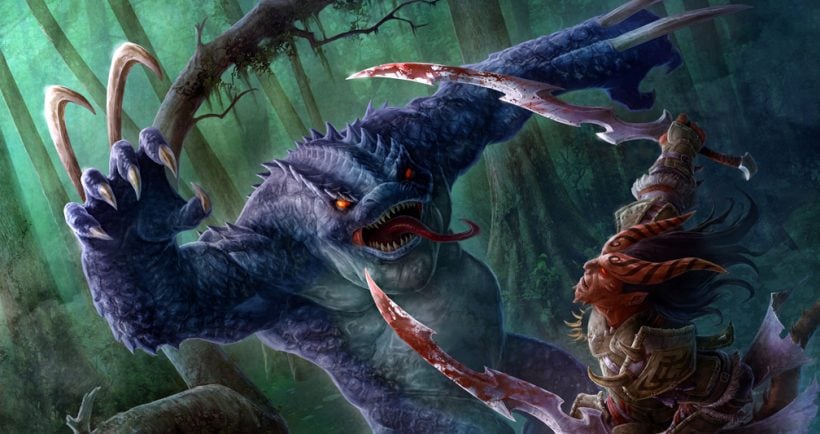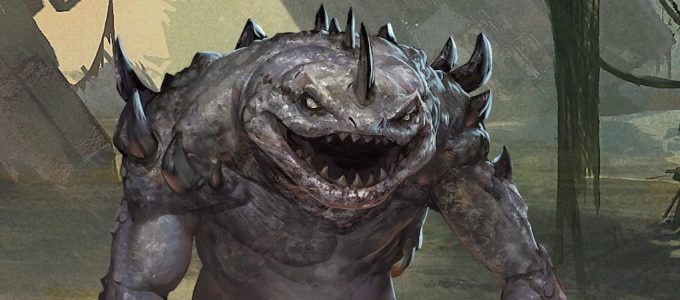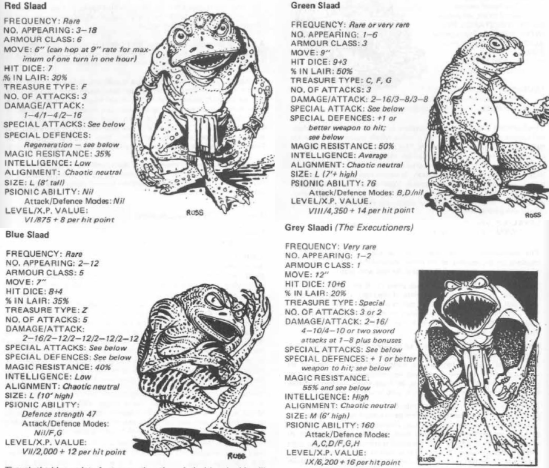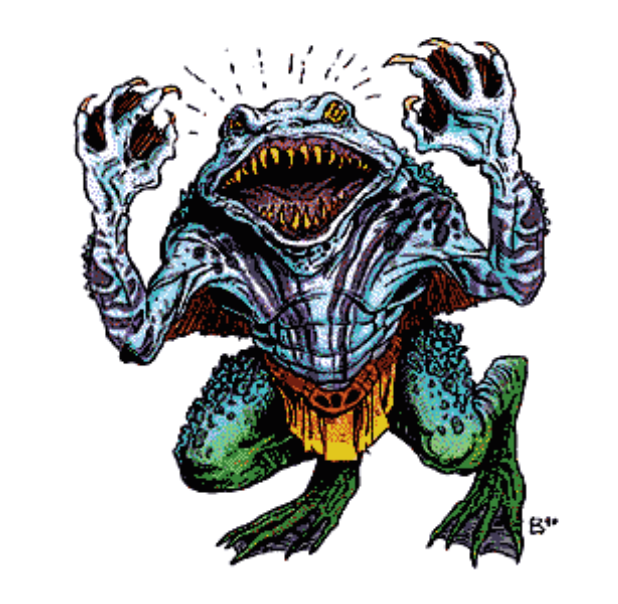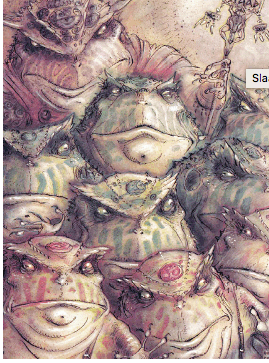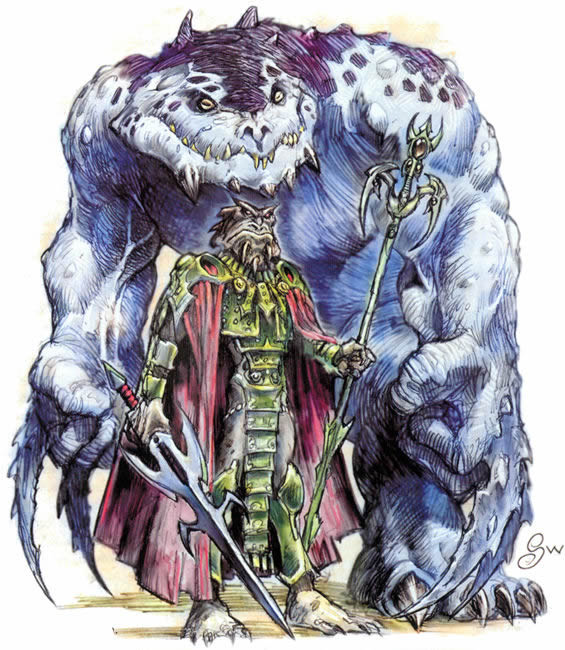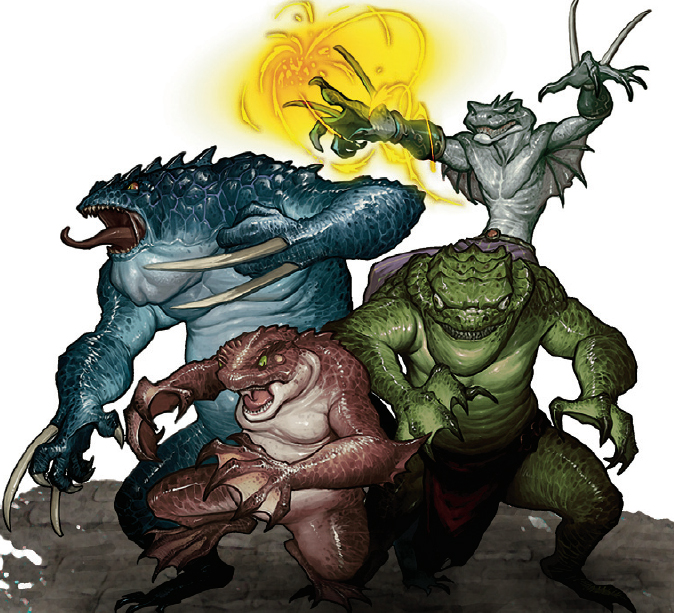Monster Spotlight: D&D’s Slaad


I hear those Blues a-calling, but I don’t know what to do with those tossed Slaad and scrambled eggs. They’re callin’ (reinforcements) again.
This week we’re taking a look at everyone’s favorite collection of frog-like extraplanar servants of chaos, color-coded for your convenience. That’s right, I’m talking about the Slaad. This week we’re dredging the chaotic depths of ever-changing Limbo to bring the Slaad into the spotlight.
…is it too late to throw them back?
First appearing in White Dwarf magazine, the Slaad have been around since the early days of D&D. Originally created by Charles Stross, who also created the death knight, githyanki, and githzerai, and whom you may recognize as the author of the Laundry Files series of books (among others, but that’s why he’s popular in my neck of the woods), the Slaad were first envisioned as “representatives of, and devotees of, total chaos — with an added warped sense of humour.”
They’ve been around ever since–one of a few monsters in D&D’s catalogue that hold the distinction of being first created by a player and then adopted to official canon for the game. The Slaad have appeared in a number of products outside the pages of the various monster manuals (and fiend folios), including the Erevis Cale trilogy for the Forgotten Realms, and as villains in one of Stross’ own novels later in life.
From a distance (preferably a safe one) Slaad present an interesting paradox: they are devotees of chaos that hail from the ever-changing plane of Limbo, and yet their forms are fixed into a rigid caste system. And there are very strict rules for how each Slaad is created–rules which are literally built into each Slaad in the form of a rune-carved jewel encased within the skull of a Slaad that allows anyone holding it to control the Slaad.
So in one monster, we have represented order and chaos. And a whole lot of evil. That’s one of the things that helps add to their enduring appeal. Slaad are a manifestation of the Universe’s spiteful sense of humor.
The Green Slaad is surprisingly okay with you looking at him.
1st Edition Slaad were very well developed. While some monsters changed–or had backstories added as the editions went on, the Slaad came into being with their place in the cosmos already in mind–including details of their shadowy masters and their secret skull-jewels. Of particular note from this edition is that all Slaad could be summoned with a form of the cacodemon spell (that spell is no longer around, thanks to the efforts of a lone marine on Phobos).
Moving briefly through them, you have the Red Slaad at the bottom of the hierarchy, whose primary function is to go and raid the Prime Material Plane for slaves or supplies, which both benefits the Slaad as a whole and gives them something to do. These are the weakest Slaad, *only* doing 1d4 with each claw and 2d8 with its bite. And, of course, they can gate in reinforcements with a 35% chance of success and use power word stun once per day. And its claw attacks had a 40% chance of injecting you with a pellet that killed you if you failed your save (if you’re wondering about eggs and such, that comes later). So, y’know, pretty weak.
Blue are next, the stronger, shock-troop-esque Slaad with four claw attacks dealing 2d6 and a 2d8 bite attack. These ones are also psionically active, for some reason.
Green Slaad can cast spells–including polymorph and a 1/day 12d6 delayed blast fireball, which is more than enough to ruin any party’s day.
Next up are Grey Slaad, who are the most dangerous of the “lesser” Slaad–capable of attacking with powerful claws, or changing to human form and using either something “common” like a +2 agic sword, or 25% of the time, something like a sword of sharpness, falling back on magical powers like creating a ball of lightning that deals 8d6+6, or power word blind.
Then there’s the Death Slaad, who can cloudkill at will, drain levels with their powerful 2d10 bite, and can use a suite of high-level spells 1/day if they really need to. Exactly the sort of thing you need to ruin any party’s day.
Finally there are the Slaad Masters–only three for now–insanely powerful beings who are basically demigods or stronger. In 1st Edition you have Ygorl, Wartle (who is not a Pokemon, I’m told) and Ssendam, a student of the Alucard naming academy.
2nd Edition Slaad really doubled down on their frog-like appearance. They got a little more colorful, and would look right at home in an X-Men spinoff. Ironically, though their artwork was a serious upgrade–and they were included in the Monstrous Compendium, they were a little bit less developed in this edition.
Gone are mentions of the Slaad Lords (at least from the core entry, a later issue of Dragon would eventually introduce two new Slaad Lords Renbuu, the lord of colors and Chourst, lord of randomness), and most of their non-physical attacks are gone as well–Green Slaad in particular lose the ability to cast spells, which was what made them distinct. Grey and Death Slaad are reclassified as Great Slaad–but they too lack any magical abilities.
But it’s in 2nd edition that the Slaad’s iconic reproductive cycle begins to take shape. The death pellet from the 1st Edition Red Slaad becomes an egg pellet (which sounds much friendlier) that only has a 25% chance of going off. But if it does, it infests victims, ultiately gestating within their chest cavity until it forms a baby Red Slaad that eats its way out.
That idea was still gestating, so to speak, when Planescape came out. With the emergence of this setting, the Slaad enjoyed a renaissance–their roles were redefined, as was their look. While they still resembled frogs, they took on a much more fantastic appearance. You can see the beginnings of their 3rd Edition design here.
And in Planescape the Slaad get much more fleshed out. There’s a hatred that runs through the rigid caste system they have. Red Slaad and Blue Slaad hate each other and will only work together if forced, but, they are also dependent on each other. That’s right, it’s from Planescape that the complicated color-coded creation routine comes from. Red Slaad implant eggs that are exactly like vanilla 2nd Edition, with one exception, they give birth to a baby Blue Slaad.
Similarly, Blue Slaad gain a diseased bite that transforms their humanoid victims into Red Slaad. And if either a Red or Blue Slaad infects a powerful being (not necessarily a spellcaster) that creates the Green Slaad, who eventually becomes a Gray Slaad after a century or so (if they survive), and from there dark and powerful rituals transform the Gray Slaad into a Death Slaad, of which there are only half a dozen or so (in Planescape, anyway).
3rd Edition took the Planescape concept of the Slaad and ran with it. In this edition, the Slaad gain a number of inherent resistances that make them feel more like a uniform race–and every Slaad gains the ability to summon another Slaad at will (though they do so lightly).
3rd Edition made being Large (or larger) powerful, and most of the Slaad are large. Red Slaad become schemers, Blue Slaad become shock troops and warlords, both of them gaining powerful grappling attacks. The Red Slaad gained pounce, using their claws more often than the blues, which is ironic, because the Blues have the more prominent ones–but Blues gained telekinesis, which is one of the best spells from that edition.
Green Slaad were codified as being the result of a Slaad implanting/infecting an Arcane Spellcaster, and, much like the Gray and Death Slaad, remained much as they were in 1st Edition and Planescape. That is to say, they could still change shape, still preferred to fight with magic, and were formiddable opponents to any coming up against them. Death Slaad, in particular, gained a number of nasty abilities, like implosion or Circle of Death ensuring they could be the ruin of unprepared party.
If ever there was a monster that was ready made for 4th Edition, it was the Slaad. Already grouped together in a number of variants, each with their own distinct tactics, abilities, and roles, they slipped right into the design of 4th Edition without acquiring a number of apellations–you won’t find any Slaad Talonstrikers, or Slaad Maelstrom Callers here (those do sound kinda cool though).
They benefitted a great deal from 4th actually. Slaad were always meant to have unique abilities, and the modular, “everything is a power” design of monsters in this edition leant itself well to giving the different kinds of Slaad powers that made them seem more like what they had been established as in previous editions.
For instance, Red Slaad gained a frog-like leap, and a croak of doom that stunned foes, Blue Slaad’s claws warped targets with chaos–though, notably, the Death Slaad was gone, replaced instead with the Black Slaad (of epic level fame) who was all about entropy, oblivion, and the void. Also included–a new wrinkle in the Slaad lifecycle: the Slaad tadpole.
5th Edition streamlines the Slaad a great deal. They lean more into the flavor of the monsters, bringing them more in line with their 1st Edition roots–although with plenty of that Planescape Flavor mixed in for good measure. Red and Blue Slaad are surprsingly simple, relying more on a regenerating pool of hit points and magic resistance to keep them alive rather than any magical ability. Green Slaad are spellcasters now, with an at will flame attack that sets people on fire. Gray Slaad are the breakout stars of this edition, gaining innate spellcasting and magic weapons for any attack they choose to make.
And there you have it. All the tools you need to make a veritable army of invading chaos-spawned monsters perfect for any situation, no matter the edition you play. I’m going to call the article here though, because I don’t know how much longer I can go without spelling it salad on accident.
Got a favorite slaad story? Want to see more Planescape love? Let us know in the comments!

